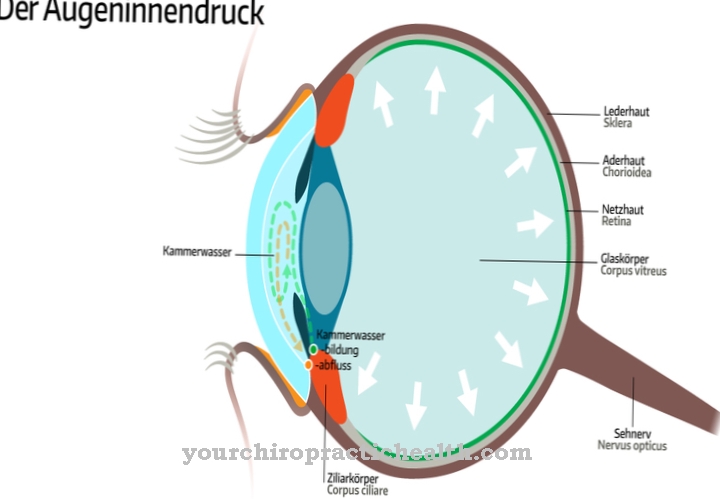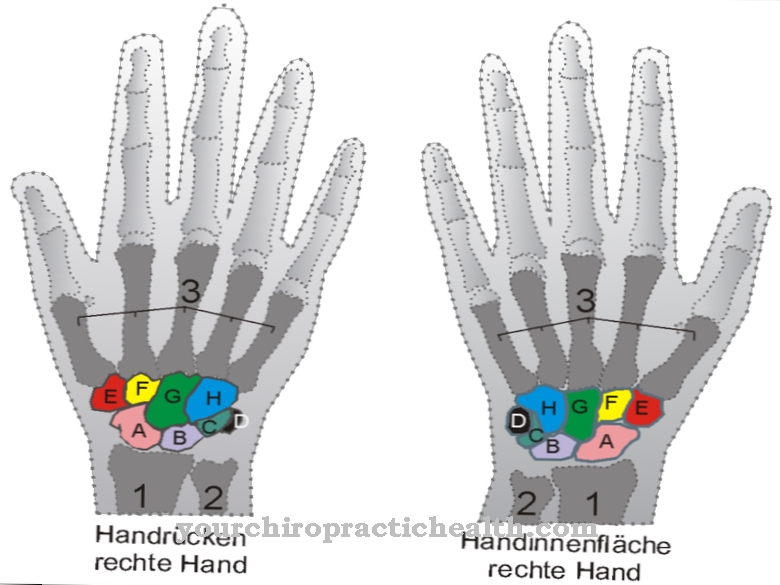The Photoreceptors are light-specialized sensory cells on the human retina. They absorb various electromagnetic light waves and convert these stimuli into bioelectrical excitation. In hereditary diseases such as retinitis pigmentosa or cone-rod dystrophy, the photoreceptors perish bit by bit until blindness occurs.
What are PRs?
Photoreceptors are light-sensitive sensory cells that specialize in the process of seeing. Light creates an electrical voltage potential in the sensory cells of the eye. The human eye contains three different types of photoreceptors.
In addition to the rods, these include the cones and the photosensitive ganglion cells. Biology differentiates between the photocells of vertebrate and invertebrate animals. Depolarization takes place in the invertebrate photocells. This means that the cells react to light by reducing the voltage. In those of vertebrates, however, hyperpolarization takes place. Your photoreceptors ensure that the voltage increases when there is light.
Unlike invertebrates, vertebrate photoreceptors are secondary receptors. The transformation of the stimulus into an action potential therefore only takes place outside the receptor. In addition to humans and animals, plants also contain photoreceptors so that they can counteract the incidence of light.
Anatomy & structure
There are about 120 million rods on the retina of the eye. The cones add up to around 6 million of around one million ganglion cells in the eye is around one percent sensitive to light. The most light-sensitive photoreceptors are the rods. The blind spot of the eye does not contain any receptors other than the cones.
Therefore, humans should actually see a hole where the blind spot is. This is only not the case because the brain fills the void with perceptual memories. The rods of the retina contain so-called disks. The cones, however, contain membrane folds. In these areas they are equipped with the so-called visual purple. Overall, rods and cones have a similar structure. They each have an outer segment in which their most important tasks are carried out.
The outer segments of the cones are conical in shape and are wider than the long and narrow outer segments of the rods. A cilia, i.e. a plasma membrane protuberance, connects the outer and inner segments of the receptors. The inner segments each consist of the ellipsoid and a myoid with an endoplasmic reticulum. The outer granular layer of the photoreceptors connects the cell body with the cell nucleus. An axon with a synaptic end in ribbon or plate form attaches to the cell body. These synapses are also called ribbons.
Function & tasks
The photoreceptors of the human eye convert the electromagnetic waves of light into bioelectrical excitation. The function of all three types of photoreceptors is to absorb and convert light. This process is also known as phototransduction. To do this, the receptors pick up the photons of the light and initiate a complex, biochemical reaction to change the membrane potential. The change in potential corresponds to hyperpolarization in vertebrates.
The three different types of receptors have different absorption limits and thus differ in terms of their sensitivity to certain wavelengths. The main reason for this is the different visual pigment in the individual cell types. This means that the three types differ somewhat in their function. The ganglion cells regulate the day-night rhythm, for example. The rods and cones, on the other hand, play a role in image recognition. The rods are primarily responsible for seeing light and dark.
The cones, on the other hand, only play a role in daylight and enable color recognition. The photo transduction takes place in the outer segments of the photo cells. In the dark, most photoreceptors are in a non-stimulated state and have a low resting membrane potential due to their open sodium channels. When you are at rest, you permanently release the neurotransmitter glutamate. But as soon as light falls into the eye, the open sodium channels close. The potential of the cells increases and hyperpolarization takes place.
During this hyperpolarization, the activity of the receptor is inhibited and fewer transmitters are released. This declining release of glutamate opens the ion channels of the downstream bipolar and horizontal cells. The impulse from the photoreceptors is transmitted through the open channels to the nerve cells, which then activate ganglia and amacrine cells themselves. The signal from the receptors is sent to the brain, where it is evaluated with the aid of visual memories.
You can find your medication here
➔ Medicines for visual disturbances and eye problemsDiseases
A variety of ailments and diseases can arise with regard to the photoreceptors of the human eye. Many of these manifest themselves as a progressive loss of sight. Cone-rod dystrophy, for example, is a form of hereditary retinal dystrophy that causes photoreceptors to perish.
With this hereditary disease, the patient continually loses cones and rods through retinal pigment deposits. This process manifests itself in the early phase as reduced visual acuity, increasing sensitivity to light and increasing color blindness. The sensitivity in the central visual field decreases. Later on, the disease also attacks the peripheral visual field. Symptoms such as night blindness can arise. After a while, the patient is likely to become completely blind.
The retina pigmentosa, also known as rod-and-cone dystrophy, must be distinguished from this disease. In the end, the same symptoms occur in this form of retinal disease as in cone-rod dystrophy, but the symptoms are reversed. This means that retinitis pigmentosa first manifests itself in night blindness, while night blindness for rod and cone disease is only symptomatic in the later course.
The course of the retina pigmentosa is usually less severe than that of the rod-and-cone dystrophy. In addition to these degenerative diseases, the sensory cells of the visual perception apparatus can also be affected by inflammation or be damaged by accidents.












.jpg)



.jpg)










.jpg)
